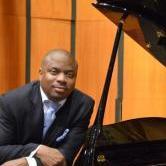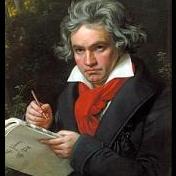Search the Community
Showing results for tags 'chamber music'.
-
So, here is the final (?) version of my very first, serious, String Quartet. I'm very excited about this piece -with its newly minted final movement. A bit of detail is in order: I. Andante con moto: The first movement, in an expanded ABA form, is in Episodic Form. This form, patterned after both the Medieval Estampie and Baroque Fugal Forms, consists of alternating exposition and contrapuntal series. I took care here to focus the material to create a sense of ABA form itself -where as the material itself dictated. The chief material for this movement is the nomenclature for my first name: JASON =DbABbDE. This was arrived at adjusting the note to letter key by removing Fb and Cb -as I didn't feel comfortable having either in the score.... it just didn't seem right, lol. II. Moderately: This movement is more through composed in that the material dictated where to go next -with the exception of the end. This movement plays with the theme from the first movement and introduces a, rather stark, GCD motif (I'll let people figure out the meaning of this chord). This chord is not elaborated on or development -just sort of sits in the ethereal of the piece throughout. However, the chord does impact the material that comes after its introduction in a profound way. III. Largo molto Sostenuto: Resignation to fate. I feel this movement is perhaps the strongest of the three -and the most interesting. While I love dense contrapuntal textures, this movement rests its laurels on a delicate suspension that begins with the GCD chordal motif introduced in the second movement. The JASON motif is imposed within the chordal motif using what I call the Shostakovitch crescendo (see his String Quartet no. 15). In a sense, that work deeply inspired this movement. I hope you enjoy! I may rework the second movement to make it less bulky at the ending -maybe fix the transitions? I'm not sure. Technicalities aside: This work is rather personal -obviously since I used my name as the chief material. The hidden programmatic nature of the work is probably easily noticeable to many of us on here. We have all gone through vast struggles in our lives to get to the points we each find ourselves. This work is biographical in that respect. I won't bore you with details.
- 5 replies
-
- 2
-

-
- chamber music
- serious
-
(and 3 more)
Tagged with:
-
This short work just sort of came to me. The form is fairly straight forward but follows a modified sonata form complete with recapitulation. I probably won't make many changes to it -except maybe expand the ending a tad (not too much though, as I'm quite happy with the overall structure of it). Hope everyone enjoys!
-
This is a piece I wrote a little while ago and forgot to post. It makes me think of my childhood home; hence the name. I know that the harmonies aren’t too advanced, and I gladly welcome advice or suggestions as to how to complicate it a little more!
- 2 replies
-
- 1
-

-
- chamber music
- oboe
-
(and 1 more)
Tagged with:
-
Hi all, So, I've been away from this site for a few years - long enough that I find it has changed and my profile is completely empty! It's time to change that. In February, I had the opportunity to perform a recital of my own works, this trio among them. My colleagues and I decided afterwards that it would be worth the trouble to do a house recording of it. This is the result. My personal musical preferences lie squarely in the conservative German branch of the 19th century, and I've always believed that a composer should write the sort of music he or she likes to hear. That's what you can expect from this trio with respect to form, harmony, rhythm, and so forth. It's in four movements. The first movement is a traditional sonata-allegro with slow introduction. The second movement is a scherzo and trio. The third is a theme and variations, based on a melody I wrote when I was 13 or 14 (side note - NEVER throw away the ideas you compose when you're young!) The fourth movement is rondo-like arch form. I hope you enjoy listening to it as much as we enjoyed performing it! I have decided against posting the score. I hate to have to take this stance, but as an essentially unknown composer, I am deeply reluctant to post my scores to an internet site that is open to the world when I know colleagues who have been victimized by thieves stealing their works and claiming them as their own. Even with a legally copyrighted work, it is stressful, time-consuming, and expensive to take these people to court. I apologize to those who would have liked to see it.
- 12 replies
-
- 5
-

-
- piano trio
- chamber music
-
(and 1 more)
Tagged with:
-
Hello everyone, Again, it's been a while since I have posted anything, and I figured I might as well post something I'm currently working on, my Piano Quartet no. 2. The complete work is almost done, and will hopefully be out soon. The performance is at the Ameropa International Chamber Music Summer School in Prague, Czech Republic. As usual, I'm playing the piano part. I apologize about the poor quality of the recording. I hope you all enjoy, and happy holidays, everyone! 🙂
-
This is a piece that I posted on another forum but I have since made many changes. I don’t really have much to say about the piece but as always I am welcome to any advice or feedback. By the way, the peace calmed me so I called it Serenity.
-
This is a piece I just finished. It’s more of a draft, and the main reason I’m posting it hear is for feedback and advice on how to make it better. As for the title, I have synesthesia when it comes to relating music and musical notes to colors, and this piece as a whole just really put the color Indigo in my head.
-
This piece was something I put together a while ago. It isn’t to complex and like usual, I’m always welcoming to advice on how to make the harmony a bit more complicated.
- 2 replies
-
- 1
-

-
- chamber music
- mallets
-
(and 3 more)
Tagged with:
-
Hi everyone! This is the second movement of my string quartet, with this being the slow contrasting movement! I have decided to go in a different direction from the 1st movement by making this movement feel much more meandering and winding, sort of like a foray into the unknown, with a distinct 'home' theme. My intention is to delve and explore a diverse range of emotions and textures throughout the piece, with a sense of wonder and in a contemplative mood. I used a large range of contrast in terms of the orchestration and instrumentation, from the solo, quasi-cadenza passages present in all 4 instruments, to lyrical polyphony with many countermelodies. Your feedback is greatly appreciated! Thank you!
-
This is a piece I wrote last week. I have separated the ‘movements’ by one measure long rests, and I understand if that may seem a bit too long; I have made them shorter in my more recent pieces. The reason I named it “Try, Try Again” was because the second and fourth movements reminded me of someone making a mistake whereas the other movements sounded like someone achieving or succeeding. I also included a quote on the last page of the score that I felt went along with the title of the piece.
-
Hi guys, Here is a part of a Trio for violin, cello and piano I composed in 2017. What do you think?
- 6 replies
-
- 1
-

-
- chamber music
- live recording
-
(and 1 more)
Tagged with:
-
Hello! This is a suite of seven miniatures for string quartet inspired by the illustrations of the Major Arcana of the Rider-Waite tarot card deck, first published in 1910. I don't personally believe in fortune-telling (though there's no judgment from me if you do), but the illustrations in this deck of cards are simply gorgeous. There are 22 Major Arcana in all, from Number 0 (The Fool) to Number 21 (The World), so I decided to split up the work into three volumes. The Fool (No. 0) will make an appearance as the introduction for each volume, since this card typically is used to represent the person receiving a tarot card reading. This first volume is roughly 10 minutes long, in 7 movements of various lengths. Form and harmony are in a looser style than I'm normally accustomed to writing in. I tried to write in a style that could be considered 'timeless', if that makes sense. This is a first draft; there may be errors in the score. Any and all feedback is welcome. The MP3 and score were produced with MuseScore 3. Thanks for listening!
-
Hello everyone, I am back, this is my new piece, hope you like it and welcome your commentation.
- 2 replies
-
- romanticism
- original
- (and 5 more)
-
Fanfare for My Brother Score.pdf In a passing conversation, Dr. Thurman had told me about how he was selecting repertoire for orchestra brass literature that included euphonium. This topic has always been a “thorn in the side” for euphoniumists worldwide especially for me as a compsoer. Although I knew they would probably never be played, I would write orchestra music with euphonium in college hoping one day the orchestra world would fall in love with instrument. Reflecting on that “pain”, I told Dr. Thurman I was going to rework a piece specifically just for him to conduct and called his own. I reached in my vault and throughly revised a piece originally called “Water to Wine” to “Fanfare for My Brother” to show my gratitude to someone who truly is my “Brother from another mother.” Here's from a read-through recorded on the phone.
- 15 replies
-
- 3
-

-
- brass
- orchestra bass
-
(and 1 more)
Tagged with:
-
Hello everybody! I've just posted my first string quartet, called "Impetuous". Here's the link for it! I was very much inspired by Villa Lobos' 6th string quartet, and wrote the first movement with it in mind. It's called "Impetuous" because I was trying to convey the sense of progress and continuity through rhythmic impetuosity, instead of using harmony or any other technique to do so. Therefore, the staccato sound and counterpoint/imitation was of great use. Also, I'm currently working on the third and last movement of a Sonata for Oboe and Piano, so if you're interested in listening to it, please subscribe to my Youtube channel. I genuinely hope you enjoy the piece, and would love to get feedback on it! Thanks for your attention! Best wishes, Jean.
-
These 2 pieces for Piano Trio were written for the Moscow Conservatory's 2018 International Winter School, along with the Etude-Tableau in B-flat minor, Op. 6. The musicians who performed it were Mikhail Akinfin and Alexandra Parfeneva, from the Piano Quartet performance, with of course myself at the piano. I might combine these 2 pieces (not conjoin them!), and possibly add more movements to make a full Piano Trio, with a possibly programmatic element to it. Here are the performances on Youtube: Nocturne in C major, Op. 5: Romance in E major: I hope you all enjoy. 🙂 Theo
-
I have decided to make a progress post for my suite so that I can get feedback on each of the movements without having to make multiple posts. This starting post will be about the first movement of my suite. I initially planned for the melody to not be in ternary form while the harmony was in ternary form, but the melody ended up being in ternary form. I chose the key of G major because it sounds warm to me. To reinforce this, I decided on the instrumentation being string quartet + piano. I use a sequence to modulate from G major to D major as a transition into the B section. So, I guess you could call it ternary sonata form, whatever that means. I include a short canonic passage in the B section of the piece after I have established D major as the tonality. Afterwards, there is a short transition back to the A section. This emphasizes the subdominant and even includes plagal motion. After the themes of the A section are played, there is a passage that includes 2 creschendos. And then the movement ends with a plagal cadence at fortissimo. What do you think of it? Did I get that warm, sunny quality that I was aiming for? Here are the mp3 and pdf:
- 3 replies
-
- chamber music
- chamber ensemble
-
(and 1 more)
Tagged with:
-
Dear Young Composers, The Symphonic Society of Limeira recently opened a call for scores for chamber music and symphonic works. Please consider submitting your work. For more information regarding this call for scores, click in the link bellow. https://www.sinfonicadelimeira.com.br/call-for-scores Best regards,
-
- chamber music
- call for works
-
(and 2 more)
Tagged with:
-
Guten Tag! This is one of the projects I have been working on this semester! Feel free to check out the concept behind it at this blog post: Composition Notebook: "Morning Birds" - the story. What I am attaching for ya'll is the full score (which includes the cues for the three different flute parts, but not the actual parts), one of the flute parts (so you can see what they look like), a MIDI rendering of all the orchestra and flute parts combined, and a MIDI rendering of just the orchestra part (Titled "Three Violin Version..."). One of the flaws of the combined MIDI file is that the flute parts are made up of several short fragments/'bird calls',as you will see in the attached flute part, and the players will be improvising which bird call they play when. In other words, it will be a much more organic process than a computer just playing them all in order, as happens in the recording. I think the MP3 of everything combined sounds pretty terrible and clamorous which is not at all the intent of the piece. I suspect that this chaos will be lessened considerably when real players are performing this. If anyone has experience writing this sort of thing, I would really appreciate any advice you'd have to offer. Also, I am happy to hear comments from anyone about this piece, whether they be about the orchestral writing, the special effects, or anything else. Thank you and enjoy!
- 3 replies
-
- chamber music
- orchestra
- (and 11 more)
-
Sopran/Soprano: Anđela Todorović /Cello: Mateja Nikolić/Piano: Veljko Nenadić Composer: Veljko Nenadić 22.12.2018. Belgrade Philharmonic Hall, Serbia.
- 2 replies
-
- classic
- chamber music
- (and 7 more)
-
This piece is my first multi-movement composition, and was written in 2016-2017. It was, at the time, my largest completed completed composition, with a full performance lasting about 25 minutes. The piece was originally conceived as a piano concerto, and the now-first movement was initially going to be the slow movement, in a similar manner to the third movement of Brahms' Piano Concerto no. 2. However, I came across a composition competition called the Young Composers Challenge, or The Composium, and decided to turn it into a shorter chamber piece. The original concerto-version lasted over 15 minutes, and the maximum timing was 5 minutes. So, a lot was cut from the original concerto-version (which, I should mention, was not orchestrated or completed), but the results were just as satisfying, though the cropping of it was rather painful. The piece was first performed at a small chamber music festival for students, with myself at the piano, in 2016. I ended up actually winning a place in competition, and it was performed, again, with myself at the piano that same year. By that time, however, I was making more movements for the piece, and finally, the completed version was performed in Moscow, for the concert for the 2017 International Summer School of the Moscow Conservatory. So, that is the story of my Piano Quartet in B-flat major, Op. 3. The quartet is in 4 movements: Movement 1. - Moderato, quasi andante (B-flat major) Movement 2. - Intermezzo: Allegretto moderato (F major) Movement 3. - Moderato (B-flat major) Movement 4. - Finale: Furioso (B-flat minor-major) The musicians in the Moscow performance are: Mikhail Akinfin - violin, Alexandra Zhelvakova - viola, Alexandra Parfeneva - Violoncello, and me as the pianist. I unfortunately do not know who the other performers in the Composium concert were. Here are the performances: I hope you all enjoy. 🙂 Theo
-
This was my first chamber work, which I wrote when I was 9 or 10 years old. It was written for a concert of chamber music by various students at a music school. I later used the main theme in one of the variations of my Passacaglia Op. 1. Here is the performance on Youtube. The group playing is called the Fifth House Ensemble. I hope you all enjoy. 🙂 Theo
-
I wrote this little piece while still composing the Piano Quartet, Op. 3. Actually, I was sort of taking a break from writing it, having just finished being part of a small chamber music festival for students, where the first movement of the quartet was premiered. The piece was written for a violinist friend of mine, named Sophia Molina. The piece had 2 performances, both of which Sophia and I played in. Here is one of the performances, the only one I have on my Youtube channel: I hope you all enjoy it. 🙂 Theo
-
Unfortunately, the first movement is unfinished 😉 1 Adagio- Allegro comodo (unfinished).mid 2 Andante calmo.mid 3 Menuetto.mid 4 Andantino (Double Variations).mid
-
Hello everyone, I am back, this is an original Chinese folk music composed by me, hope you like it, and welcome everyone's commentation.
- 3 replies
-
- chinese folk music
- chamber music
-
(and 2 more)
Tagged with:









